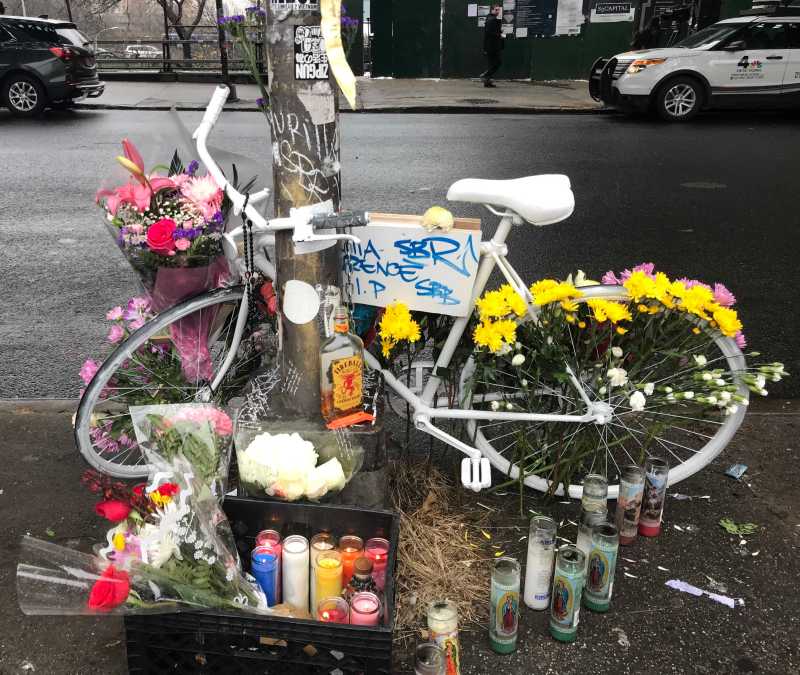Working Cyclists Mourn One of Their Own — And Demand More Safety

More than two dozen delivery cyclists mourned one of their own on Friday afternoon just hours after she was killed by a hit-and-run truck driver in Brooklyn — and decried the road violence and bad street conditions that make New York City’s streets unsafe for everyone, even professional riders.
The still-unidentified motorist behind the wheel of what police say was a grey tanker truck struck 25-year-old Aurilla Lawrence as they both were traveling along Broadway towards Rodney Street in Williamsburg at about 11:30 pm Thursday night. The driver rolled over Lawrence’s body, and fled.
Lawrence’s friends and fellow delivery cyclists gathered Friday afternoon where she died, placing flowers, balloons, and candles at the city’s newest white ghost bike — and they also sent a message to city officials that even the most experienced riders are roadkill to reckless drivers.
“She was a really good biker. The world is fucked up, you can lose people everyday, but biking in New York City, we shouldn’t be dying,” said Ryan Kuonen, an avid cyclist and member of Community Board 1’s transportation committee. “She was experienced.”
There’s no doubt in any of Lawrence’s friends’ minds that the driver was to blame — he or she simply wasn’t paying attention or wasn’t properly sharing the road, a scenario that’s all too familiar to Kuonen, who once narrowly escaped her own death because of pure luck.
“I have no doubt the fucking driver just didn’t bother to look because of the weather and just didn’t think there would be a biker out and he fucking killed someone and didn’t even notice,” she said. “There needs to be enforcement of trucks and visibility. I’ve been biking responsibly and the only reason I wasn’t killed is because of dumb luck at that moment.”
Lawrence is the first cyclist killed at Broadway and Rodney Street, but the overall number of pedestrian and cyclist injuries the neighborhood is rising, despite Mayor de Blasio’s Vision Zero initiative.
From January, 2013 through January, 2014, there were 1,396 crashes causing injuries to 702 cyclist and 718 pedestrians. In the same amount of time covering January, 2016 through January, 2019, there were 1,399 total crashes resulting in 724 injured cyclists and 714 injured pedestrians.

Council Member Antonio Reynoso, whose district includes the spot where Lawrence was killed, said Vision Zero doesn’t work until not one more person dies on the street. He called for a safety redesign of the dangerous area, which functions as a feeder for cars and trucks to the Williamsburg Bridge.
“It’s just so difficult for us to figure out a way to make it so these streets are safe, so people are not killed,” Reynoso said. “Vision Zero doesn’t work until there are zero fatalities in the city. It’s making progress but progress is not success, we got a long way to go.”
But change is needed now, since the area is such a busy route for cyclists riding to and from the bridge, said Lawrence’s roommate Danijela Dusanic.
Dusanic was even stopped by police on the same street just hours before Lawrence was killed because she went through a red light — which she said she did to stay in drivers’ line of vision and to escape the heavily congested and dark area underneath that’s especially dangerous for riders.
“I ran a red light because it’s so congested and so crowded — this is a gauntlet here, there’s no bike lanes, they are savages in cars and trucks and it’s a construction site here entirely now,” said Dusanic, who had the grim task of officially identifying her friend’s body on Friday morning after she never came back to their Bedford-Stuyvesant home the night before. “You never feel safe, it’s a death trap.”
Even so, Dusanic will keep riding because that’s what Lawrence would want, she said.
“I don’t think she’d want to evoke fear in people,” said Dusanic.
Transportation Alternatives said there’s one way to reduce the fear: fix the streets: “Starting next month, when L train service to Manhattan is reduced or non-existent on nights and weekends, more Brooklynites than ever are going to opt to bike over the Williamsburg Bridge to get to Manhattan,” said the group’s interim co-Director Marco Conner. “That means more people will be biking on Broadway, which links Eastern Brooklyn and Bushwick with the bridge. But Broadway, which lacks protected bike lanes, is far from ideal for traveling on two wheels. When a driver makes one bad move on a street like Broadway, where there’s no room for error, people die.
“But it doesn’t have to be this way,” Conner added, demanding, “a true, connected network of protected bike lanes with an accelerated timeline for doing so.”
A spokesman for the Department of Transportation said officials will now take a new look at the area to see how they can make it safer, in addition to the recently installed and in-the-works bike lanes leading to the Williamsburg Bridge.
“In light of this tragic fatality, DOT will evaluate the crash location for potential further Vision Zero safety enhancements in addition to the bike infrastructure we have installed in the surrounding neighborhood,” said Brian Zumhagen.





